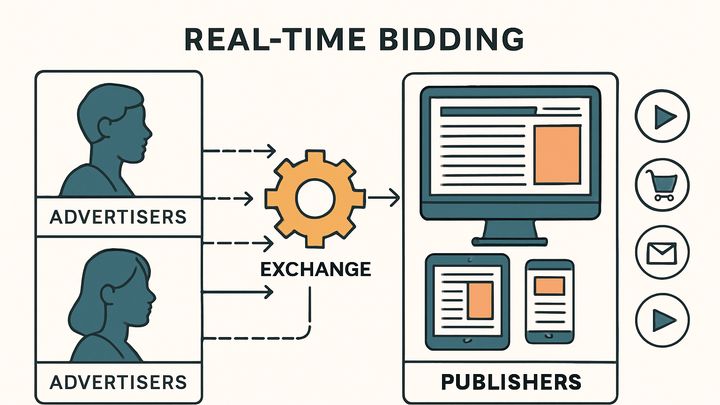Published on 2025-06-26T04:12:25Z
What is Programmatic Advertising? Examples of Programmatic Advertising
Programmatic Advertising is the automated buying and selling of digital ad inventory in real time using technology platforms such as DSPs, SSPs, and ad exchanges. It leverages algorithms and data to target audiences precisely, optimize bids dynamically, and deliver personalized ads across channels. In the analytics industry, programmatic ads can be measured and optimized with SaaS tools like PlainSignal (for privacy-focused, cookie-free insights) and Google Analytics 4 (GA4) for attribution and cross-platform tracking.
By automating media buying, marketers can scale campaigns, reduce manual overhead, and adjust strategies rapidly based on performance data. This approach brings efficiency, transparency, and enhanced targeting capabilities, making it a cornerstone of modern digital marketing strategies.
Example tracking code for PlainSignal:
<link rel='preconnect' href='//eu.plainsignal.com/' crossorigin />
<script defer data-do='yourwebsitedomain.com' data-id='0GQV1xmtzQQ' data-api='//eu.plainsignal.com' src='//cdn.plainsignal.com/plainsignal-min.js'></script>
Programmatic advertising
Automated real-time bidding and data-driven digital ad buying using platforms like DSPs and analytics tools for precise targeting.
Why Programmatic Advertising Matters
Programmatic advertising transforms digital marketing by automating ad buying, enabling precise audience targeting, and optimizing costs in real time. It minimizes manual processes and leverages data to deliver relevant ads at scale.
-
Efficiency & scale
Automation replaces manual insertion orders, speeding up campaign launches and allowing advertisers to scale efforts across multiple channels simultaneously.
-
Real-time decision making
Algorithms adjust bids and placements dynamically based on live auction data.
-
Dynamic allocation
Budget shifts to top-performing inventory without manual intervention.
-
-
Data-driven targeting
Leverages first- and third-party data to reach specific audience segments with tailored messaging.
-
Audience segmentation
Segments based on demographics, behavior, and interests.
-
Frequency capping
Controls ad exposure frequency to prevent over-serving.
-
-
Cost optimization
Real-time bidding ensures advertisers pay the optimal price for each impression.
-
Bid strategy
Automated algorithms set bids to align with ROI goals.
-
Performance-based budgeting
Allocates spend to top-performing placements.
-
How Programmatic Advertising Works
The core mechanism of programmatic advertising is real-time bidding (RTB) within ad exchanges, mediated by DSPs and SSPs. Each ad impression is auctioned in milliseconds as a user loads a webpage or app.
-
Real-time bidding (rtb) process
A live auction where impressions are bought and sold in milliseconds.
-
Bid request
Published when a user visits a page, containing user and context data.
-
Bid response
DSPs submit bids based on targeting criteria and bid strategies.
-
Auction win
Highest bid wins, and the ad is served instantly.
-
-
Key components
Success relies on a coordinated ecosystem of platforms.
-
Demand-side platform (dsp)
Where advertisers set targeting and bids.
-
Supply-side platform (ssp)
Where publishers offer inventory.
-
Ad exchange
The marketplace where DSPs and SSPs transact.
-
Example Implementation with PlainSignal and GA4
This section shows how to set up a programmatic campaign and measure its performance using PlainSignal for cookie-free analytics and GA4 for advanced attribution.
-
PlainSignal setup
Install the PlainSignal tracking snippet to collect privacy-focused engagement data.
-
Code installation
Embed the following snippet before closing </head>:
<link rel='preconnect' href='//eu.plainsignal.com/' crossorigin /> <script defer data-do='yourwebsitedomain.com' data-id='0GQV1xmtzQQ' data-api='//eu.plainsignal.com' src='//cdn.plainsignal.com/plainsignal-min.js'></script> -
Data collection
PlainSignal captures pageviews, events, and user interactions without cookies.
-
-
Integrating GA4
Use GA4 to track conversions and user journeys across devices.
-
Tag configuration
Set up GA4 tags via Google Tag Manager or gtag.js.
-
Event tracking
Define custom events (e.g., ad click, form submit) to feed campaign data.
-
-
Measuring campaign performance
Combine PlainSignal insights with GA4 attribution models to optimize bids and creative.
-
Key metrics
Monitor CTR, CPA, ROAS, and audience engagement.
-
Optimization loop
Use A/B tests in GA4 and adjust targeting in your DSP based on performance.
-
Best Practices and Considerations
Ensuring effective and compliant programmatic campaigns involves privacy safeguards, creative strategies, and ongoing optimization.
-
Privacy compliance
Adhere to regulations like GDPR and CCPA when handling user data.
-
User consent
Implement consent management platforms.
-
Cookieless strategies
Leverage first-party data and cookieless analytics like PlainSignal.
-
-
Frequency capping & ad fatigue
Prevent oversaturation by limiting impressions per user.
-
Cap settings
Configure daily or campaign-wide caps in your DSP.
-
Creative rotation
Rotate ad creatives to maintain freshness.
-
-
Continuous optimization
Use data to refine targeting, budgets, and creative assets over time.
-
A/b testing
Test variations of ads and landing pages.
-
Performance reviews
Schedule regular audits of campaign KPIs.
-
